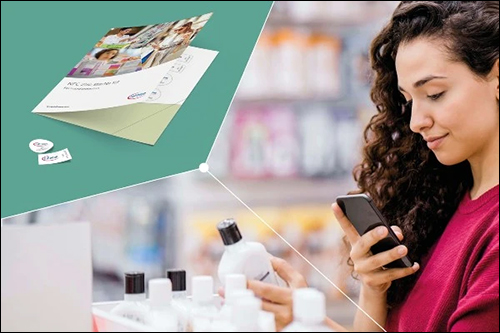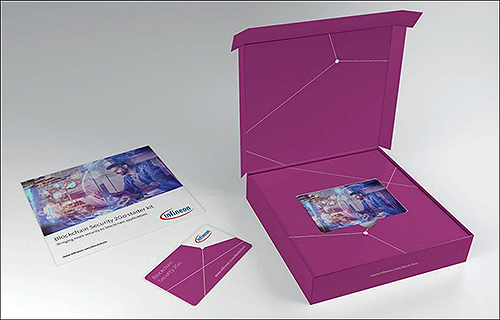Sep 21, 2022Consumer product brands and systems integrators are building applications around a Near Field Communication (NFC) tag for authentication and digital content that features encryption and options for programmable memory storage and is available through an open standard. Infineon's NFC4TCxxx tag was released in August, along with a starter kit aimed at easing the development process and the testing of solutions. The tag, specifically designed to provide product authentication and brand engagement, is now being tested or implemented on high-value goods.

The NFC4TCxxx tag
The tag leverages an industry-standard security architecture and includes user-programmable memory that allows brands to embed customer engagement or warranty and maintenance records in every product's tag, says Vijayaraghavan Narayanan, the company's director and head of its NFC Product Group. The NFC4TCxxx tag employs AES-128 cryptography and is equipped with inherent resistance to physical attacks, Narayanan explains, such as differential power analysis and differential fault analysis. Memory options range from 304 bytes to 4 kilobytes, and the tags are being applied to such consumer goods as electronics, luxury accessories and other high-value products.
Infineon says it developed the new product to provide a more secure channel to authentication and consumer engagements. The company already makes NFC tags for a variety of applications, Narayanan says. Infineon has been among the key contributors to NFC technology standardization within the ISO and the NFC Forum, and Narayanan vice-chairs the NFC Forum's Sourcing Industry Group. "We are not only building products around NFC," he states, "but we are also shaping the future of NFC or contributing to it."
Cryptography to Prevent Tag Cloning

Vijayaraghavan Narayanan
The new tag, compliant with the ISO 14443 standard, is intended for use with NFC-enabled phones, Narayanan reports. Each time the 13.56 MHz NFC tag is tapped, its unique ID number and an authentication command—derived from a cryptographic key—are exchanged. The NFC-enabled phone forwards that data to the server, where the key must match the one stored in the encryption software. If the server fails to authenticate the key, that means it's not a valid product.
One example could be products sold by professional sports teams. The NFC tags could be applied to each product, such as T-shirts, balls or other branded memorabilia. Fans would typically use an app provided by the club or team, tapping their phone to access data about a product before purchasing it. The tag could similarly be used for luxury products or apparel, to make sure they have not been counterfeited. Some users will employ the tags not only to provide a certificate of authenticity, but also to allow consumer engagement.
Most standard NFC tags being used for brand authentication and consumer engagement lack such cryptography, Infineon notes. "That's what makes this product much more reliable as an overall solution," Narayanan says. The company designed the tag based on the need expressed by brands for better NFC tag anti-cloning security. When adopting technology to ensure a product's authenticity, such companies required absolute assurance that the solution could not be hacked. "If we're going to have brand authentication," he states, "the data really needs to be secure."
Multiple Memory Size Options

The NFC 2Go starter kit
The tags are available in a variety of memory sizes, depending on a user's particular application. They range from a relatively small memory size of 304 bytes (for storage of the unique ID and security key only) to a high memory of 4 kilobytes (in which a large amount of data can be stored). That memory flexibility could open opportunities for additional applications, Narayanan says. For instance, some brands may want to store consumer-engagement content or a promotional code directly on the tag, without requiring that the data be accessed via the cloud.
One application for high-memory storage could be used by brands for electronic products. The tag could store data related to a specific product's lifetime, which could start with a warrantee that a retailer could write to the tag prior to a sale. Consumers or service personnel could easily access that information by tapping their phone against the tag. Following that, if a tagged item required regular maintenance or servicing, that data could be written to the tag by maintenance providers, thereby creating its history both in the cloud and on the tag.
The tag's open-standard feature offers a benefit for those deploying a large solution that might require flexibility in the future, the company reports. The tag follows the CIPURSE open-standard cryptographic protocol, a vendor-neutral international standard for transit and payment via NFC technology. That means a system using the Infineon tags could work with other NFC tags following that same standard. To use the encryption keys, however, they would still require Infineon tags and software.
Starter Kit and Support
The company's NFC 2Go starter kit is intended to help those using the new Infineon tag build authentication solutions. Developers could employ the kit to build their system with Infineon's app or into their own app. The kit includes NFC4TCxxx NFC sticker tags, as well as iOS and Android mobile apps, back-end cloud-based authentication software, tag-personalization tools and a user guide. It also includes a GitHub repository so systems integrators can easily access and download sample codes, along with app snippets, enabling users to more easily build solutions and integrate them with their own apps.
To support those developing their own applications, Infineon will provide custom support. "We offer services to help them identify the right tag and the right form factor," Narayanan says, adding, "We have a strong relationship with our partners as well, who can then work on the right form-factor design and give the brand a complete, holistic solution." NFC is enjoying greater adoption rates in the past few years, he adds, in part with the help of the major mobile phone brands that now support the technology. Apple's iPhones have come with open NFC functionality since the iOS 11 version debuted in 2017, while Android has offered NFC-enabled handsets for many years.
To meet the demand for NFC functionality as more applications come up, Infineon says it is offering diverse NFC products that can provide authenticity or establish credibility with brands, as well as enable customer engagement. The latest NFC tag will cost more than standard NFC tags, Narayanan notes, due to the additional functionality. "It is marginally more expensive because of the value it brings," he states. "We have tried to hit that sweet spot in which it is affordable," while offering greater security and memory capacity. The NFC4TCxx tags and the NFC 2Go starter kit are available now.
Key Takeaways:
- Infineon's new NFC tag comes with options focused on security and flexibility as more brands express the need for such features.
- The tag comes at a time when NFC technology use is growing by high-value product makers, including luxury apparel and electronics.

